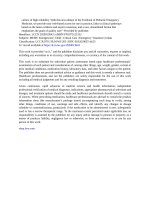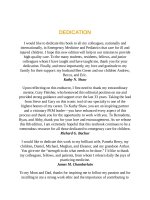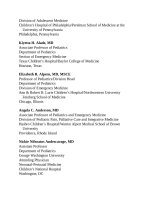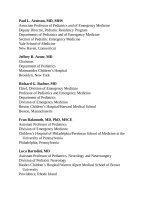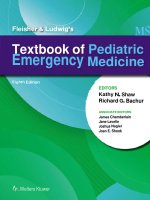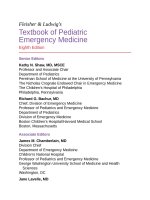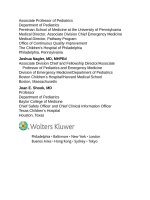Pediatric emergency medicine trisk 805
Bạn đang xem bản rút gọn của tài liệu. Xem và tải ngay bản đầy đủ của tài liệu tại đây (206 KB, 4 trang )
FIGURE 104.2 Skin burns are classified as superficial, partial thickness, or full
thickness. A: Superficial burns affect only the outer layer of epidermis. B: Partialthickness burns affect the lower layers of dermis. C: Full-thickness burns destroy the
entire layer of dermis. (From Lippincott Williams & Wilkins Comprehensive Dental
Assisting , 2012: Lippincott Williams & Wilkins/Jones & Bartlett Learning, Burlington,
MA. www.jblearning.com . Reprinted with permission.)
Management
First Aid. Early cooling is accomplished by running cold water over the
injured area. If performed in the first 60 minutes after injury, it stops
ongoing thermal damage and minimizes edema, reducing progression to
full-thickness injury. Applying ice directly to the wound is often painful,
and the extreme cold can worsen the injury. Parents should be instructed not
to put grease, butter, or any ointment on the burn because these substances
do not dissipate heat well and may contaminate the area. Intact blisters
should not be broken prior to medical evaluation. Burns should be covered
with a clean cloth or bandage.
Prehospital. Prehospital care providers should focus initially on airway,
breathing, and circulation, as they would for any other patient. Rapid
transport to a hospital setting is crucial. Oxygen should be administered.
The patient should be intubated if there are signs of upper airway
compromise or impending obstruction. If transport time is likely to be
prolonged, intravenous fluids should be started.
FIGURE 104.3 Examples of burns of various depths. A: Superficial: Involves only the
epidermis. B: Superficial partial thickness: Partially injured dermis, with blistering.
Note the pink-red color and moist appearance. C: Deep partial thickness: Injury
involves all of the epidermis and most of the dermis. Note the paler, drier appearance
than superficial injuries. D: Full thickness: Involves destruction of the entire epidermis
and dermis. Note the area of pallor and charred color. These areas may also have a
leathery appearance. (Reprinted with permission from Cohen BJ, Memmler RL, Hull
KL. Memmlers the Human Body in Health and Disease . 13th ed. Philadelphia: Wolters
Kluwer; 2015.)
Emergency Department Management. Specific management of major and
minor burns is reviewed in the sections below. The final section also
addresses management of burns with specific etiologies including inflicted,
chemical, and electrical burns.
Preventing Infection. Heat causes coagulation necrosis of tissue, producing
a protein-rich medium that nourishes bacterial growth. Burns become
colonized with potentially pathogenic organisms, primarily from the skin
and intestinal flora of the patient and not from exogenous sources.
Cleansing and debridement reduce substrate for bacterial proliferation and
topical antimicrobial therapy reduces the number of microorganisms, but
burns are never completely sterilized so the risk of secondary infection is
always present. Burn wounds are not treated immediately with systemic
antibiotics unless infection is clearly present, but must be watched closely
for development of subsequent infection.
MAJOR BURNS
CLINICAL PEARLS AND PITFALLS
The placement of a sterile sheet over burned areas can provide
effective analgesia.
Consider carbon monoxide and cyanide exposure with house fires
and do not delay treatment in suspected cases.
Current Evidence
Risk of morbidity and mortality is associated with the size of the burn. A
large, single-center, prospective study of pediatric burn patients found
mortality rates ranging from 3% (30% to 39% TBSA) to 55% (90% to
100% TBSA). In this study, burn size of 62% TBSA was the marker of a
significantly increased mortality risk.
Goals of Treatment
The initial management of the significantly burned patient includes
protection of the airway, maintenance of breathing, and support of
circulation, all with the goal of preventing mortality and disability. Initial
airway assessment needs to include evaluation and management of potential
direct inhalational injury and resultant airway edema, as well as inhaled
toxins including carbon monoxide and cyanide. Patients should receive
supplemental oxygen, as well as appropriate antidotal therapy for
toxicologic exposure, respiratory support as needed (potentially including
escharotomy for circumferential chest burns), and appropriate intravenous
fluid resuscitation to support their circulatory status. The goal is to optimize
wound care and pain management to minimize disability and improve
cosmetic and functional outcomes.
Clinical Considerations
In the appropriate clinical circumstances (fire, usually in an enclosed space)
it is important to consider carbon monoxide and cyanide poisoning. For
carbon monoxide, one should administer 100% O2 and send a
carboxyhemoglobin level. Indications for potential hyperbaric treatment
include loss of consciousness at the scene, persistent neurologic symptoms
including seizure, evidence of cardiac injury, or significant elevation of
carboxyhemoglobin levels (>25% to 40%). The decision to pursue
hyperbaric treatment should be made in conjunction with a toxicologist,
poison control center, or hyperbaric physician. Cyanide poisoning must be
treated before the quantitative level is available. Indications to consider
hydroxycobalamin treatment for cyanide toxicity include history of
cardiopulmonary resuscitation (CPR), abnormal vital signs, intubation,
evidence of hypoxic injury, and severe metabolic acidosis.
Clinical Recognition
Recognition of the severely injured burn patient is based on a combination
of the severity of burn and TBSA involved. Burn shock occurs in adults
with burns over 30% of BSA but may occur in children with burns over
only 20% of BSA. Circumferential burns and full-thickness burns are of the
highest concern.
Triage Considerations
Please see triage guidelines in Table 104.1 . Major burns should be triaged
to rapid physician assessment and care.
Clinical Assessment
As part of the primary trauma survey, the clinician must be vigilant in
carefully evaluating all patients for evidence of inhalational injury. Patients
with a history of fire exposure in an enclosed space, soot in the nose or
mouth, or facial or airway burns may require intubation for airway
protection. These patients may also require treatment for carbon monoxide
and cyanide exposure. In the secondary survey, it is of the greatest
